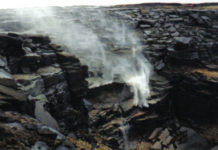The wealthy island of Atlantis was supposedly peopled by virtuous citizens, boasted golden walls and silver temples, pleasure gardens and a racecourse, but was destroyed in anger by the god who had fashioned it. The story of Atlantis is well known, yet when and where this utopia existed, if ever it did, remains a mystery. For more than two millennia, the legend of an idyllic golden age enjoyed by the citizens of a fabulously wealthy island continent – swept away in an overnight cataclysm – has gripped the Western imagination.
The Greek philosopher Plato’s description of the rise and fall of Atlantis has inspired some 2000 books and untold years of investigation. And, although more than 40 sites have been suggested for this legendary utopia, there is still no evidence that it existed at all.
In his dialogues Timaeus and Critias, penned in the fourth century BC, Plato gave the first written account of an island ‘larger than Libya and Asia Minor together’ and the people who profited from its bounty. Atlantis was given to Poseidon, god of the sea and earthquakes, at the sharing out of the earth. The Atlanteans were all descended from the god and Cleito, the mortal woman whom he married.
Plato’s vivid description of Atlantis has inspired many pictorial reconstructions. The capital, according to Plato, boasted a 14 mile (22.5km) wide complex of canals, walls, gardens, barracks and a race track arranged in circles around a royal palace and temple.
According to Plato, Atlantis was a mighty maritime nation, lying beyond the Pillars of Hercules (the present-day Strait of Gibraltar) and dominating the Mediterranean as far as Egypt and Turkey. It was a place rich in natural resources, with an abundance of food. High mountains provided shelter from the northerly winds, and animals – including elephants and horses – roamed its meadows and drank from its lakes and streams. Ten kings reigned over the ten regions of this remarkable island paradise, whose citizens coexisted in perfect harmony. ‘They were obedient to the laws, and….despised everything but virtue….giving little thought to the possession of gold and other property.’ Not only were they model citizens, the people of Atlantis were also great horsemen and skilful helmsmen.
In time, however, the Atlanteans grew discontented with their many blessings and tried to extend their domain throughout the entire world. In the climactic battle that ensued. Athens stood alone against Atlantis and prevailed.
The Poseidon turned his wrath on the island: around 9500 BC a terrible cataclysm struck and in one violent day and night Atlantis disappeared beneath the waves, along with all trace of its existence.
Plato was adamant that the story was true, and quoted as his source a tale told to an Athenian statesman, Solon, some 200 years earlier and then passed down orally. Viewed as history (although even Plato’s pupil Aristotle did not accept the truth of the narrative), the rise and fall of Atlantis poses two problems: its date and location. The earliest known civilization developed in the region of modern Iraq around 3500 BC, and there are no traces of settled communities at all before 7000 BC. There was no Athenian city-state to wage war against Atlantis in 9500 BC. Nor were horses known in Europe until the Bronze Age (around 3000 BC), yet they are mentioned frequently in Plato’s Atlantis.
The principal difficulty in citing Atlantis is Plato’s insistence that it lay beyond the Pillars of Hercules, which is inconsistent with both of today’s preferred locations: the Greek island of Thera (Santorini) and Troy. In 1992 Dr. Eberhard Zangger, a German geoarchaeologist – that is, a practitioner of the science of linking archaeology to changes in the landscape – published the result of a ten-year study into the location of Atlantis, entitled The Flood from Heaven. He maintains that Troy on mainland turkey fits Plato’s description of the site of Atlantis. It stands to the north of a plain adjacent to narrow straits, is buffeted by strong northerly winds, and there are hot and cold springs nearby.
More persuasively, he believes that the epithet ‘Pillars of Hercules’ was applied to the Strait of Gibraltar only around 500 BC. Before that time, he says, the term was used to describe the Dardanelles, the strait separating Europe and Asia, leading to the Black Sea. As for Plato’s contention that Atlantis drowned (while Troy did not), he argues that around 1200 BC flash floods did indeed submerge those parts of Troy located on the plain.
Dr. Zangger’s theories have yet to be evaluated fully, but until they are, the favorite site for Atlantis remains Thera. There are many similarities between Plato’s description of Atlantis and the archaeological remains of the Bronze Age civilizations of the Aegean (3000-1500 BC).
Excavations in the 1960s at Akrotiri on Thera by the Greek archaeologist Professor Marinatos have uncovered the remains of a large Bronze Age city thought to be an important commercial centre of the Minoan civilization. Houses two or three storeys high and richly decorated with frescoes bear witness to Thera’s prosperity. Around 1500 BC calamity befell the island: Thera’s volcano erupted with great force and the whole island was ‘swallowed by the sea’.
The sheer cliffs of Thera (Santorini) bear witness to the cataclysm that befell the island around 1500 BC. Excavations have revealed the remains of a rich Bronze Age civilization here, with frescoes and artefacts similar to those discovered on Minoan Crete, 75 miles (120km) to the south. Items associated with a bull cult fit Plato’s description of the Atlanteans’ religious preferences.
The rim of a crater some 31 sq. miles (80km) in extent is all that remains of the once towering volcano of Thera. Evidence suggests that the blast was felt as far away as Crete and the western coast of Turkey, and it is likely that the ash from such an eruption blocked out the sun over the whole of the eastern Mediterranean for several days. In addition, the eruption of Thera is contemporary with, and almost certainly related to, the collapse of the powerful and prosperous Minoan civilization on Crete.
An Irish-American scholar and politician, Ignatius Donnelly (1831-1901), published Atlantis: the Antediluvian World in 1882. Much of his theory about the lost continent was fanciful, but his location of the island in the mid-Atlantic fits Plato’s description. He looked at the similarities between mythologies, languages and customs of ancient civilizations on both sides of the Atlantic, such as the Ancient Egyptian and pre-Columbian cultures, and suggested that Atlantis – sunk midway between the Old and New Worlds – provided the cultural bridge between them. He also dated the destruction of Atlantis to the final retreat of the last great Ice Age, around 8000 BC, when glaciers melted and the oceans rose to unprecedented heights.
Neither Troy nor Thera fits the date ‘9000 years before Solon’ of Plato’s Atlantis. One theory supposes that this is due to the simple mistake of adding a nought. If Plato had meant ‘900 years before Solon’, the date would have coincided neatly with the eruptions on Thera.
It may never be possible to say whether Plato was describing fact or fiction. If it could be proven beyond doubt that an error was made in the date and that the Pillars of Hercules did not always refer to the Strait of Gibraltar, the riddle of Atlantis might be solved.
-end-




































